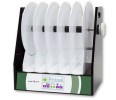Authors
W. Van Leuven, D. Van Dam, L. Moens, PP. De Deyn and S. Dewilde
Lab
Department of Biomedical Sciences, University of Antwerp, Universiteitsplein 1, Belgium
Journal
Biochimica et Biophysica Acta
Abstract
Neuroglobin (Ngb), a neuron-specific heme-binding protein that binds O2, CO and NO reversibly, and promotes in vivo and in vitro cell survival after hypoxic and ischaemic insult. Although the mechanisms of this neuroprotection remain unknown, Ngb might play an important role in counteracting the adverse effects of ischaemic stroke and cerebral hypoxia. Several Ngb overexpressing mouse models have confirmed this hypothesis; however, these models were not yet exposed to in-depth behavioural characterisations. To investigate the potential changes in behaviour due to Ngb overexpression, heterozygous mice and wild type (WT) littermates were subjected to a series of cognitive and behavioural tests (i.e., the SHIRPA primary screening, the hidden-platform Morris water maze, passive avoidance learning, 47 h cage activity, open field exploration, a dark–light transition box, an accelerating rotarod, a stationary beam, a wire suspension task and a gait test) under normoxic and hypoxic conditions. No significant behavioural differences were found between WT and Ngb-overexpressing mice at 3 months old. However, one-year-old Ngb-overexpressing mice travelled more distance on the stationary beam compared with WT littermates. This result shows that the constitutive overexpression of Ngb might counteract the endogenous decrease of Ngb in crucial brain regions such as the cerebellum, thereby counteracting age-induced neuromotor dysfunction. This article is part of a Special Issue entitled: Oxygen Binding and Sensing Proteins.
BIOSEB Instruments Used:
Aron Test or Four Plates Test (LE830),Rotarod (BX-ROD)

 Pain - Thermal Allodynia / Hyperalgesia
Pain - Thermal Allodynia / Hyperalgesia Pain - Spontaneous Pain - Postural Deficit
Pain - Spontaneous Pain - Postural Deficit Pain - Mechanical Allodynia / Hyperalgesia
Pain - Mechanical Allodynia / Hyperalgesia Learning/Memory - Attention - Addiction
Learning/Memory - Attention - Addiction Physiology & Respiratory Research
Physiology & Respiratory Research
 Pain
Pain Central Nervous System (CNS)
Central Nervous System (CNS) Neurodegeneration
Neurodegeneration Sensory system
Sensory system Motor control
Motor control Mood Disorders
Mood Disorders Other disorders
Other disorders Muscular system
Muscular system Joints
Joints Metabolism
Metabolism Cross-disciplinary subjects
Cross-disciplinary subjects Preclinical studies and opioids: role in crisis management in the United States
Preclinical studies and opioids: role in crisis management in the United States 